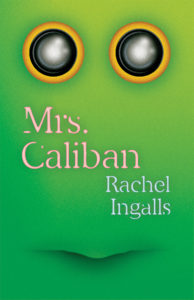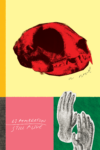Rachel Ingalls’s Mrs. Caliban begins like your typical monster B-movie. A dangerous creature has escaped a government facility, and a community is in danger. The next development is recognizable to fans of films like ET or the more recent TV show Stranger Things: an unsuspecting housewife Dorothy takes in “Aquarius the Monsterman” and realizes that he’s not dangerous at all. He takes on the name Larry. But then, rather than follow the monster movie plotline and focus on Larry’s escape, Ingalls lingers on the part of the story that most monster movies gloss over. Larry and Dorothy figure out how to live together, as they settle into a cozy and romantic (albeit, temporary) domesticity, building a life together away from her husband’s and the public’s attention.
In this regard, Mrs. Caliban is a novel that explores the things that stick around for too long, becoming part of our everyday experience, after they’ve outlived their expected shelf life. Ingalls uses Dorothy and Larry’s strange arrangement to probe the ways we build lives together. The couple’s conversations often revolve around Dorothy’s explanations of human activities, as when Larry asks about her different outfits and their social significance: “To me, it’s a habit. Everybody agrees that certain clothes are worn for certain activities. Once the habit is accepted, it means something.” Indeed, Dorothy’s explanations suffice to fit her and Larry into a legible relationship. By navigating these social norms, they settle into their routine. He spends most days watching TV, listening to music and helping her clean the house. But as Dorothy attempts to explain society’s larger machinations, their conversations fall apart:
It was the first question she had failed to explain since her collapse over the subject of industry and progress. She had started with the introduction of agriculture, the coming of industry, the exploitation of women, the fact that it all started in the home where there was no choice, the idea that eventually robots and machines would release people to live a life of leisure and explore their own personalities; but, just before she reached that point, she forgot how to wind it up . . . She had stopped, confused, and added, “But what people really want is to be happy.”
Dorothy and Larry’s desire to be happy has no place in society’s order. Not only does the outside world hate Larry, but both figures desire for their own lives also runs counter to society’s “industry and progress.” They’re both stuck in the past, dwelling on suffering from which they’re unable to recover. Rather than progress beyond it, Dorothy and Larry both seek to recuperate the past.
While Dorothy and Larry have their share of Mork and Mindy-esque mix-ups, Ingalls zooms in on their recognizably human suffering, as she illustrates the empathy that brings these two figures together. Dorothy lives with her uncaring and unfaithful husband, Fred, who fails to emotionally support her after the loss of her son Scotty and pet dog Bingo (whose death somehow hits more heavily, as he was supposed to provide comfort after she loses Scotty). Ingalls’s darkly comic portrayal of Dorothy’s melancholic life becomes the basis for a genuine empathetic connection between her and Larry. Ingalls intimately understands how each lover’s past suffering is brought to bear, traumatically, on their present lives together.
This trauma becomes most apparent in Larry’s case. He is the product not only of scientific experiments but also sexual and physical abuse at the hands of the scientists at an ominous “Institute,” from which he escaped. After he and Dorothy have sex for the first time and she learns of his past, “she felt incapable of making him understand how such a thing could have happened, and why the same thing done for different motives could be either good or bad, and what these ideas meant.” Even in the face of incomplete understanding and the inability to erase, or even forget, the past, Dorothy and Larry’s life together provides something like healing for them both. Because Dorothy and Larry stick it out, finding a way to live and love together, rather than instantly flee society, Ingalls reveals her own investment in recuperating something that was once thought lost, worthless, or even hated.
Ingalls counterpoises Dorothy’s and Larry’s intense and painful remembering against the other characters in the novel. She introduces the characters’ differences in the novel’s opening sentence: “Fred forgot three things in a row before he reached the front door on his way to work.” Beyond merely forgetting keys and newspapers, Fred’s forgetfulness becomes an uncaring coldness as he emotionally deserts Dorothy and cheats on her with other women. Dorothy similarly contrasts with her best friend Estelle (who has had an affair with Fred, unbeknownst to Dorothy). As the two discuss past romances, it becomes apparent that Estelle is Dorothy’s opposite, overly ready to move on and forget. “The whole point about it was that it was then, not now,” she claims at one point. Whereas Dorothy and Fred exacerbate their differences through a lack of communication, Estelle and Dorothy have frank conversations, such as when Estelle tells Dorothy, “You don’t understand the nature of desire.” This is a curious accusation. It might be more accurate to say that Dorothy desires differently: she desires that things might be different. Dorothy’s entire relation to the world seems predicated on the desire for something impossible, whether that is an amphibious lover or merely a less painful past. In Mrs. Caliban, Ingalls’s brilliance shows through her ability to unite the utterly ridiculous and the deeply empathetic longings that Dorothy feels.
The sheer tragedy at the heart of the novel is not that everyone around Dorothy dies, as she frequently accuses. Rather, the tragedy is that she remembers these losses more intensely and emotionally than others, who are ready to forget as quickly as possible. She thus suffers the incumbent pain of these losses in a way that is lost on those around her. Larry is her one savior in this regard (even if, as Ingalls hints, but never says outright, he is merely a figment of her imagination). Their reminiscence reaches its romantic heights in an exchange as they cuddle in a car overlooking the sea:
“Yes, I’ve always loved the sound of the sea. I think everybody does.”
“For me, it’s the sound of where I live. That’s hard to explain. It’s always there, like your heartbeats. Always, for our whole lives, we have music. We have wonderful music. The sea speaks to us. And it’s our home that speaks. Can you understand?”
“You must be lonely.”
“More than anything. More than hunger. Even hunger sometimes goes away, but this doesn’t.”
It’s unclear whether Ingalls wants us to take this scene entirely seriously. After all, it is a melodramatic rewriting of a staple scene in every monster movie – an unsuspecting couple shares a romantic moment at “Make-Out Point.” But again, Ingalls disrupts the B-movie tropes. No monster strikes. Instead, Dorothy finds a way to love the monster. Mrs. Caliban opens the possibility that we might come to love what society has rejected.
Ingalls imagines a world where we value counterfactuals and remembrances: the lost possibility of what might have been. These are the same values upheld by publishers like NYRB Classics, Dalkey Archive Press, and New Directions (who is reissuing Mrs. Caliban this November), which have all associated themselves with works in translation and reissues of overlooked and out of print books. But these presses’ dual mission of translations and reissues is not as obvious a pairing as it seems; they are not self-evidently the same task. Translation breaks down many barriers that reissues do not (that of language most obviously), but a reissue breaks down wholly different barriers that don’t affect works in translation in the same way. Whereas translation expands our reading world — bringing books from across the globe into our bookstores — reissuing a book specifically rescues that book from the past’s obscurity. If translation is concerned with space, reissues are concerned with time, with giving us a chance to try again. It usually re-introduces a book to an audience, nation, or other reading public that could have read it before. But they didn’t. Beyond giving a book a new introduction and cover art, a book’s republication opens the possibility that we might be able to read differently this time around, reclaiming a work from its tragic obscurity. To reissue a book involves hoping that history repeats itself, but this time with a difference. Even if this book was already lost, overlooked, and underappreciated once, you can’t shake the fact that it’s stayed with you. You love these past books not for what they were, but for what they still are to you — and might be to somebody else.
Perhaps, then, Mrs. Caliban is better read as a reissue. The novel is campy, similarly to what Susan Sontag identifies: “things are campy, not when they become old — but when we become less involved in them, and can enjoy, instead of be frustrated by, the failure of the attempt.” But Mrs. Caliban is not the “pure” camp that interests Sontag. Before time has passed, and the book has “become old,” Ingalls already embedded her own “failures” of B-movie tropes, only to subvert and play with them, integrating a camp-like detachment at the same time that she explores genuine emotional connections. Even in its original publication, there’s a certain sense in which Mrs. Caliban reads simultaneously as both camp and not.
This (non-)campiness resembles the novel’s persistent reissues. After its initial publication in 1982, The Harvard Common Press put out another edition. A 1986 New York Times review of that reissue lingered on the “unfortunate unsalability” of Ingalls’s novels, as though even at the moment of the novel’s resurgence, it was already due to go back out of print. Since then, Mrs. Caliban has received notice from Rivka Galchen, who called it a “perfect novel” in her essay “The Only Thing I Envy Men,” published in The New Yorker last year (that essay was also collected in Galchen’s Little Labors, from New Directions). Even as she gives Mrs. Caliban mainstream recognition in venues like The New Yorker, Galchen’s characterization of the novel is fleeting, as she laments that Mrs. Caliban – while “perfect” – remains unavailable to us.
There’s a sort of conflict at the heart of Mrs. Caliban that expresses itself in Ingalls’s B-movie plot, the publishers’ reissues, and the reader’s approach to the book. It demands that we both take it seriously and don’t. In fact, this is how Dorothy, Larry, and Ingalls teach us to approach the past – whether it’s tragedy we linger on or the farce we laugh off – it’s something that we certainly and always remember.
At the book’s end, Dorothy learns to love the past in this way. As the novel progresses, the couple creates less painful memories, which serve as the basis of their pleasure together. At the book’s end, after Larry had fled into the ocean and Dorothy has lost Fred in a spectacular car accident, she finds solace in her time with Larry:
The water ran over the sand, one wave covering another like the knitting of threads, like the begetting of revenges, betrayals, memories, regrets. And always it made a musical, murmuring sound, a language as definite as speech. But he never came.
Amidst the wreckage of her life, Dorothy clings to the memories she shared with Larry. The sea’s music becomes a reparative substitute for the past’s “revenges, betrayals, memories, regrets.” Dorothy’s remembering, even as it initially caused her pain, eventually becomes her saving grace. Perhaps this is what brings us back to the book, again and again. It’s the way it teaches us to live with the past, to find both solace and joy, as we go on living – and reading – in the present.
Adam Fales grew up in Kansas and recently graduated from Fordham University. He is a manager at Book Culture in New York City and has also written for the American Antiquarian Society’s Past is Present, the Journal of the History of Ideas’s blog, and the Los Angeles Review of Books. You can find him on Twitter @SupplyanddeMan.
This post may contain affiliate links.








